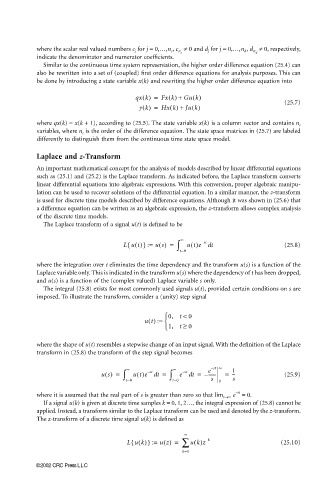Page 805 - The Mechatronics Handbook
P. 805
0066_Frame_C25 Page 4 Wednesday, January 9, 2002 7:05 PM
≠ 0, respectively,
where the scalar real valued numbers c j for j = 0,…,n c , c n ≠ 0 and d j for j = 0,…,n d , d n
c d
indicate the denominator and numerator coefficients.
Similar to the continuous time system representation, the higher order difference equation (25.4) can
also be rewritten into a set of (coupled) first order difference equations for analysis purposes. This can
be done by introducing a state variable x(k) and rewriting the higher order difference equation into
qx k() = Fx k() + Gu k()
yk() = Hx k() + Ju k() (25.7)
where qx(k) = x(k + 1), according to (25.5). The state variable x(k) is a column vector and contains n c
variables, where n c is the order of the difference equation. The state space matrices in (25.7) are labeled
differently to distinguish them from the continuous time state space model.
Laplace and z-Transform
An important mathematical concept for the analysis of models described by linear differential equations
such as (25.1) and (25.2) is the Laplace transform. As indicated before, the Laplace transform converts
linear differential equations into algebraic expressions. With this conversion, proper algebraic manipu-
lation can be used to recover solutions of the differential equation. In a similar manner, the z-transform
is used for discrete time models described by difference equations. Although it was shown in (25.6) that
a difference equation can be written as an algebraic expression, the z-transform allows complex analysis
of the discrete time models.
The Laplace transform of a signal u(t) is defined to be
{
Lu t()} := us() = ∫ ∞ ut()e – st t d (25.8)
t=0
where the integration over t eliminates the time dependency and the transform u(s) is a function of the
Laplace variable only. This is indicated in the transform u(s) where the dependency of t has been dropped,
and u(s) is a function of the (complex valued) Laplace variable s only.
The integral (25.8) exists for most commonly used signals u(t), provided certain conditions on s are
imposed. To illustrate the transform, consider a (unity) step signal
0, t < 0
ut() :=
1, t ≥ 0
where the shape of u(t) resembles a stepwise change of an input signal. With the definition of the Laplace
transform in (25.8) the transform of the step signal becomes
–
us() = ∫ ∞ ut()e – st t d = ∫ ∞ e – st t d = – e ------- st ∞ = 1 (25.9)
--
t=0 t=0 s 0 s
−st
where it is assumed that the real part of s is greater than zero so that lim t→∞ e = 0.
If a signal u(k) is given at discrete time samples k = 0, 1, 2…, the integral expression of (25.8) cannot be
applied. Instead, a transform similar to the Laplace transform can be used and denoted by the z-transform.
The z-transform of a discrete time signal u(k) is defined as
∞
Lu k()} := uz() = ∑ uk()z k – (25.10)
{
k=0
©2002 CRC Press LLC

